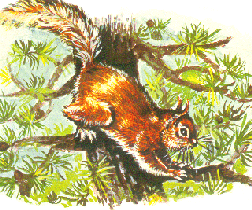
 Red
Squirrel(Iora Rua) --:
Red
Squirrel(Iora Rua) --:
is a small, reddish, tree- living animal with a long bushy tail. It is
smaller than the grey squirrel, also found in Ireland.
We have a red squirrel in our classroom. He is called Sammy. He was knocked down by our teacher a few years ago. He got him stuffed and brought him into school because his wife did not like the look of him. He is now the class mascot. He keeps an eye on us when the teacher has to leave the room on a message.
Its
summer coat is red and during summer the he has large ears tufts. Their ear
tufts are lost in the winter when his fur changes colour to a brownish grey.
As a result, he is often confused with the grey squirrel. You will know the
grey squirrel from the red squirrel, by its size and its home. The grey
squirrel has a longer body and lives in deciduous (trees which loose their
leaves in Autumn) and mixed woods. The red squirrel builds its nests or drey
in trees well above ground level. The drey is made up of leaves, twigs
and grasses. Squirrels can breed twice in a season, in spring and in
late summer. There are between one and six young in a litter. The young are
born naked and blind. After about eight weeks they are able to look after
themselves.
The
red squirrels are very lively during the day especially in the morning.
Their diet consists of nuts, acorns and cones. They are particularly fond of
pinecones. Squirrels often strip the bark from the trunks of forest conifer
trees but the reasons for this are not known. In some parts of Ireland whole
plantations have been damaged. Red Squirrels are lovely animals.
They
are a protected species under the Wildlife Act of 1976.
Aiden Walsh